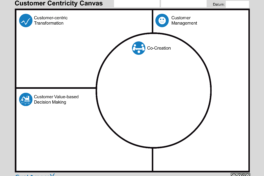More than half of all German companies still evaluate customer feedback manually. Measuring customer satisfaction therefore still has enormous potential for digitization.
The majority of German companies (75%) systematically collect data on customer satisfaction; however, more than half of the companies (53%) do not use software to analyze the collected data, but continue to evaluate it by hand. This starting point shows that improving customer orientation should often begin in the areas of customer value-based decision making and customer-centric transformation. Digitization must be used to obtain and subsequently evaluate data more efficiently. This requires a transformation of the organization.
The survey shows that the vast majority of companies surveyed (75%) currently use a customer satisfaction measurement method – most commonly the Net Promoter System (54%), followed by the traditional customer satisfaction metric (34%). The use of satisfaction measurement depends on the size and age of the company as well as the business model and industry. Among companies 50 years old or older, 82% measure customer satisfaction, and among very large companies (>50,000 employees), the figure is as high as 96%. The smaller the company, the lower this proportion. This result is always surprising, as it should be much easier in principle to measure customer satisfaction, especially for smaller companies. In terms of business models, it is clear that end-customer-oriented sectors (B2C, B2P) in particular systematically address the issue of customer satisfaction (85% and 82% respectively), whereas “business-to-business” companies neglect the issue to a greater extent – here, only 65% measure customer satisfaction. This is a major omission, which usually takes bitter revenge at the latest when trying to sell innovations.
The use of customer satisfaction measurement varies greatly within the sectors: Almost all companies in the energy and water supply (100%, n = 8), pharmaceutical, and healthcare (89%, n = 9) industries conduct customer satisfaction measurement. In contrast, customer satisfaction measurement is much less common in (online) retail (62%, n = 101) and the media and telecommunications industry (56%, n = 36). This result is surprising. The latter two industries in particular have much easier ways of measuring customer satisfaction.
In order to obtain detailed information on the components of customer satisfaction or to determine the drivers of satisfaction, companies often use follow-up questions in addition to the quantitative survey of satisfaction (e.g., with the NPS score) to be able to shed light on other dimensions of satisfaction (e.g., speed of response, friendliness, quality). Of the companies surveyed here, 66% use follow-up questions to measure satisfaction. 20% of the companies use further selection questions (so-called “multiple choice questions”) to find out about satisfaction and its drivers, 46% ask their customers for more detailed information by means of an open text field. The majority of the companies surveyed still use manual evaluation (53%). This means that the companies read (have) the individual statements and possibly categorize them (for example, by so-called coders). This manual text evaluation is quite valid and allows the detection of finest linguistic nuances, but it is very time-consuming and thus expensive. Here, the question arises, especially for smaller companies, as to how this requirement could be implemented efficiently and cost-effectively.
When asked how the information from customer satisfaction measurement is used, 64% of the companies surveyed said they improve their products and services. General goals, such as strengthening customer orientation (54%) or controlling the company (43%) also play an important role. Only a smaller proportion of companies use satisfaction measurement to identify specific customers – whether dissatisfied (34%) or delighted (24%). 8% of the companies (i.e. almost 30 of the 325 respondents) do not utilize the results of the satisfaction measurement in any way.
These results are not surprising. The focus is not on the customer but on the offers and the company. This example illustrates the fundamental misunderstanding that many people have regarding the term customer orientation. While 54% of participating companies say they plan to use data to strengthen customer focus. But customer identification or segmentation and subsequent value-oriented processing falls by the wayside. There is still a lot of educational work to be done here on what customer orientation actually is. Unfortunately, many managers still equate customer focus with quality of offer or experience rather than value-based customer relationship management. All in all, it can be stated that in many companies key figures exist now, but their extraction and use still have massive potential.




